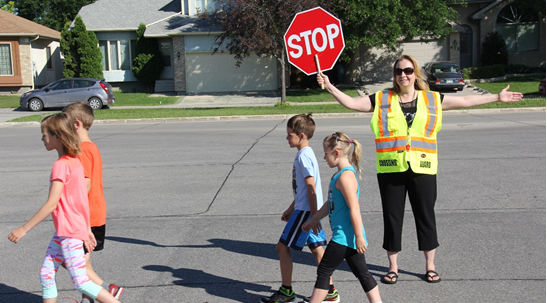Adult Crossing Guards

Typically, crossing guards are adult employees or volunteers, while school patrols are older students of the school. School crossing guards play an important role in the lives of children who walk or bicycle to school. They help children safely cross the street at complex, hazardous or congested crossing locations. They also remind drivers that pedestrians are present on the roadway. The presence of adult crossing guards can lead to more parents feeling comfortable about their children walking or bicycling to school. While the primary role of an adult school crossing guard is to guide children safely across the street, children also remain responsible for their own safety. In this manner, a guard plays another key function–a role model helping children develop the skills necessary to cross streets safely at all times.
The Public Schools Act and School Crossing Guards:
The school safety patrols and crossing guards have been in operation for over 50 years. According to Section 48 of The Public Schools Act, a school board may establish, operate, maintain and regulate a system of patrols for the protection of children from traffic accidents.
In the Pembina Trails School Division the determination of the requirement for a crossing guard is based on the complexity of the roadway, presence of hazards or congestion of crossing locations. Other factors that may be considered are the volume of traffic and pedestrians; their speed limits; turning movements; frequency of gaps or crossing opportunities in traffic; the width of the street and the number of lanes; traffic composition; presence of traffic control devices (traffic lights, signs); etc.
Qualifications of School Crossing Guards:
School crossing guards must possess the following qualifications:
- Must be at least 18 years of age;
- Must be willing to work part-time, holidays and school breaks;
- Basic first aid training, not required but considered a benefit;
- Must be able to communicate clearly with children and others;
- Mental alertness, neat appearance, good character and dependability;
- Physical Requirements: Vision and hearing sufficient to perceive potential traffic hazards, to detect warning signals, traffic control devices and other indicators of potentially hazardous situations; freedom from color blindness; and physical ability sufficient to swiftly remove pedestrians from dangerous traffic situations. Be able to stand for long periods of time outdoors. Be able to hold the stop sign for extended periods of time.
- Have good English language skills;
- Sense of responsibility for safety of students.
- Complete and pass a criminal background check/child abuse registry.
Training/Equipment and Supplies:
The school principals must arrange the initial training of the new crossing guards. Training typically occurs in the fall, at the start of the school year, and is hosted by the Winnipeg Police Department and divisional Safety Officer. For training of crossing guards that start throughout the year, please contact the divisional Safety Officer.
Each crossing guard will receives a copy of the School Crossing Guard Program Manual and a copy of the Crossing Guard Handbook at the end of the training session as well as all the mandatory safety equipment they will need for their job. The handbook can be used to review the procedures and safety practices learned during the session.
Crossing guards must successfully complete the training program before being allowed on duty alone. New recruits may benefit from observing or working with experienced guards. They can gain an understanding of traffic/pedestrian flow, ask questions of the current guards and watch the procedures being demonstrated.
If you are interested in becoming a school crossing guard, please apply online to posted positions using the following link - https://employment.pembinatrails.ca/.


Please provide your question and email address in the fields below.
Your question has been successfully submitted.
CloseThank you.